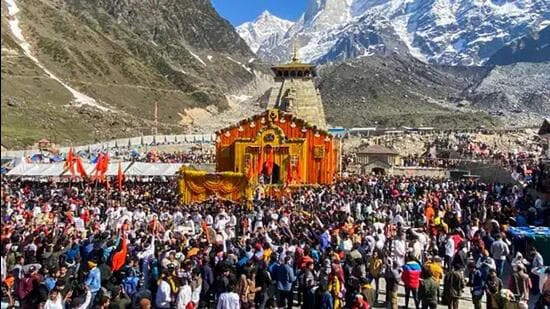Dehradun: The Uttarakhand government has asked the tourism department to prepare a comprehensive nine-point master plan for all major religious shrines across the state, following the stampede at the Mansa Devi temple in Haridwar on Sunday.
Directing the formation of a high-level committee to streamline crowd management and strengthen the safety of infrastructure at prominent religious sites in the state, chief minister Pushkar Singh Dhami said, “Crores of pilgrims visit Uttarakhand every year. A comprehensive master plan will be developed to ensure their safety and comfort. By improving public facilities around religious sites, we aim to make the pilgrimage journey more streamlined and secure.”
Principal secretary RK Sudhanshu has issued instructions to the tourism department to begin preparing the detailed master plan without delay, officials aware of the development said.
Some of the key features in the proposed plan include a modern crowd control system to manage the flow of devotees, particularly during peak pilgrimage seasons. The carrying capacity of each religious site will be scientifically assessed to prevent overcrowding.
To ensure the smooth and safe movement of pilgrims, separate entry and exit routes will be designed. Additionally, extra space will be allocated for waiting areas to reduce congestion near temple premises.
Emergency evacuation systems will also be incorporated into the infrastructure to enable a swift response during untoward incidents. A well-organised information and guidance system will be established to assist devotees in navigating the premises efficiently.
The plan also includes improved parking arrangements to reduce traffic-related inconveniences and the deployment of adequate security personnel to maintain order and respond to emergencies.
At least eight people, including a 12-year-old boy, were killed and 30 others injured in a stampede on a narrow stairway leading to a temple on July 27. Dhami visited Haridwar to assess the situation and instructed officials to prepare a roadmap that would make pilgrimage experiences safer and more efficient.
The state government has asked the divisional commissioners of both Garhwal and Kumaon to extend full cooperation in preparing and executing the plan. Authorities were also directed to prioritise the removal of illegal encroachments along pilgrimage routes to ensure unobstructed access.
Chief secretary Anand Bardhan on Tuesday directed officials to initiate expert-led crowd management surveys at temples with high footfall.
In the first phase, experts in crowd management and civil engineering will analyse five major temples – Mansa Devi, Chandi Devi, Neelkanth Mahadev, Kainchi Dham, and Purnagiri – to ensure seamless coordination and implementation. The divisional commissioners of Kumaon and Garhwal will act as nodal officers for their respective regions. “They will supervise the on-ground execution of expert recommendations, including structural and operational improvements at temple premises,” Bardhan said.
Uttarakhand has witnessed stampedes in the past too. On 15 July 1996, during the Somvati Amavasya bath at Haathi Bridge near Har-Ki-Pauri, 21 pilgrims lost their lives in a stampede. Another deadly incident occurred on 14 April 2010, during the Mahakumbh’s royal bathing day, when a stampede at Birla Ghat Bridge claimed seven lives. Many people fell into the Ganga River as a portion of the bridge’s boundary wall collapsed. A year later, on 9 November 2011, during the centenary celebrations of Gayatri Teerth Shantikunj, 16 devotees were killed and over 50 injured when a massive crowd surged towards the ritual site on the banks of the river near Laljiwala.
